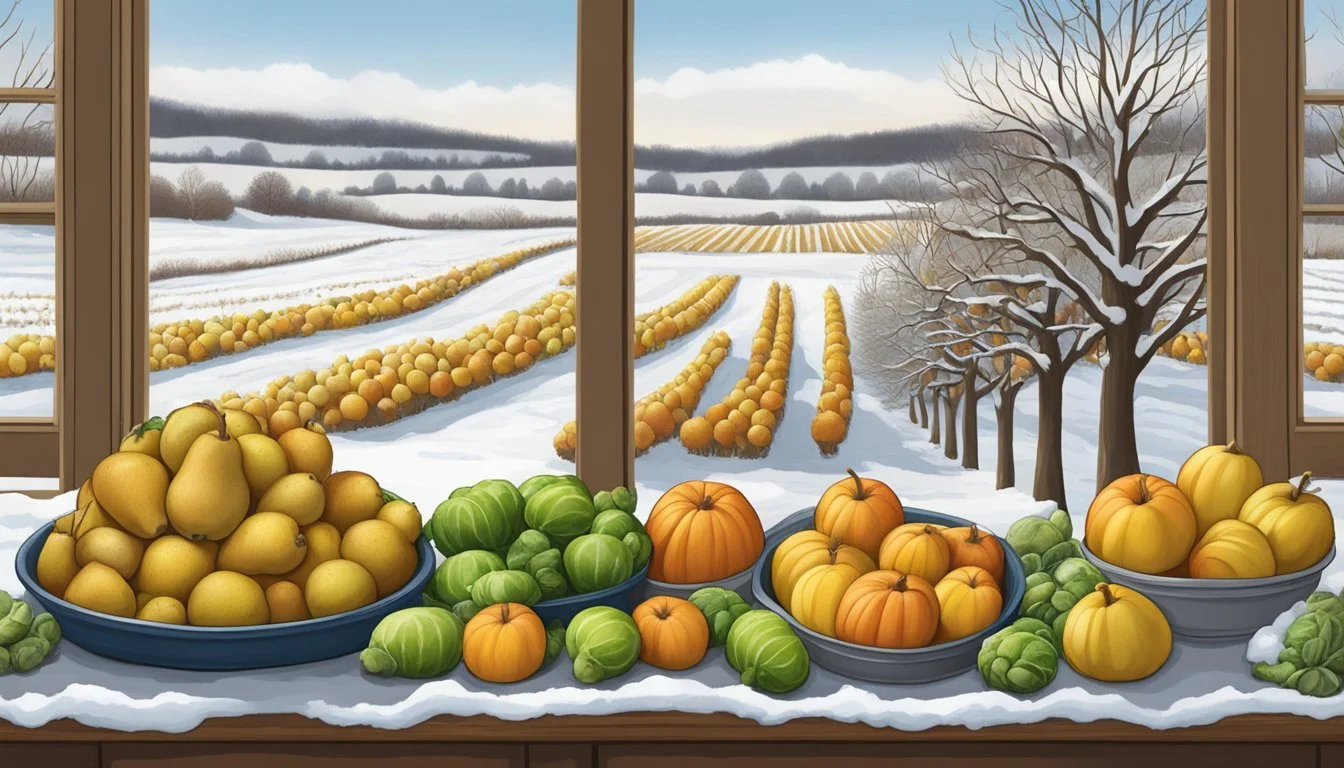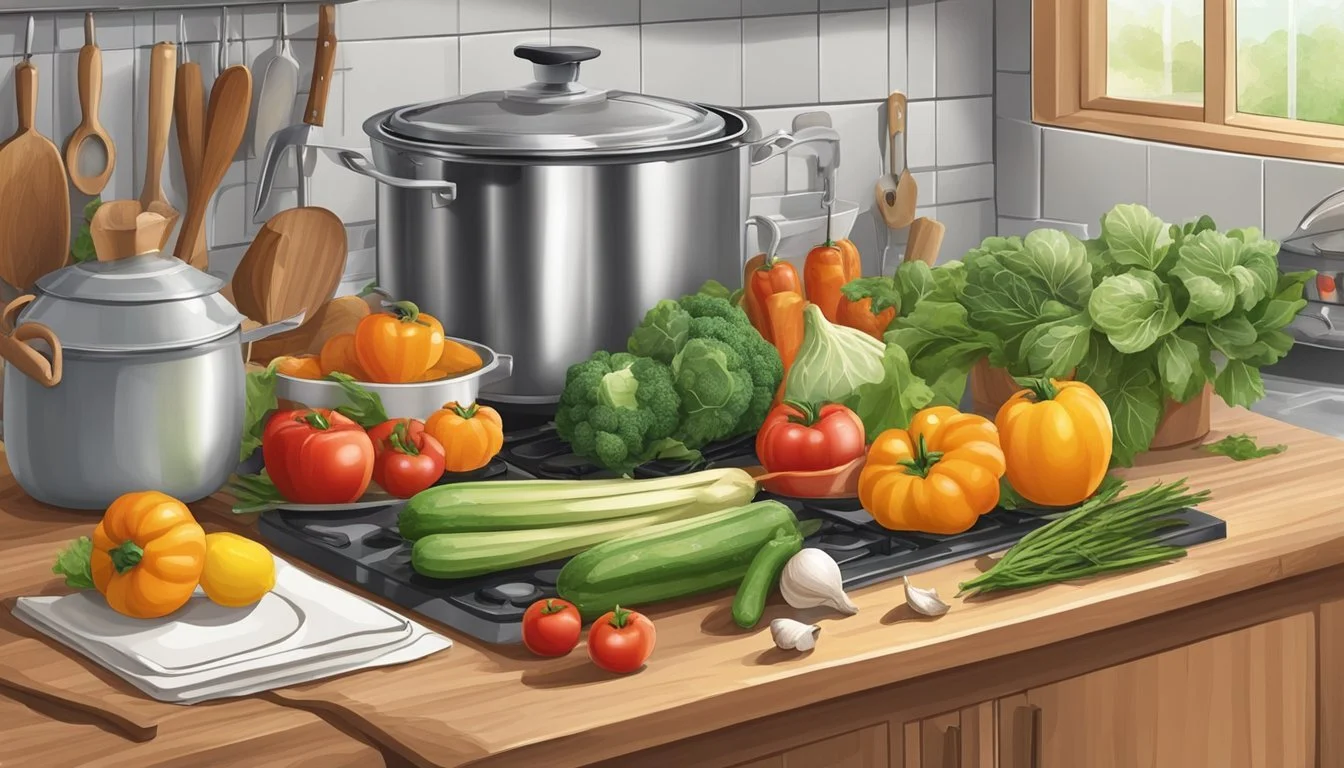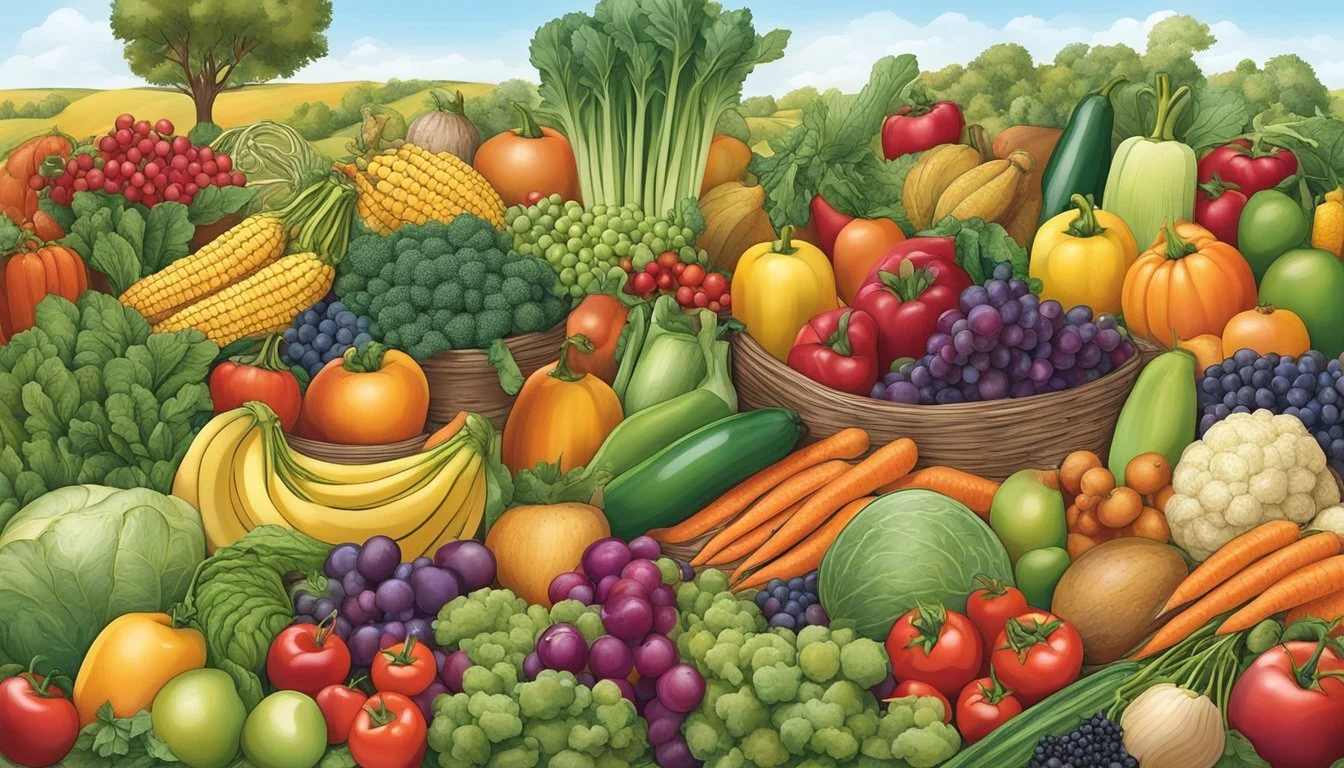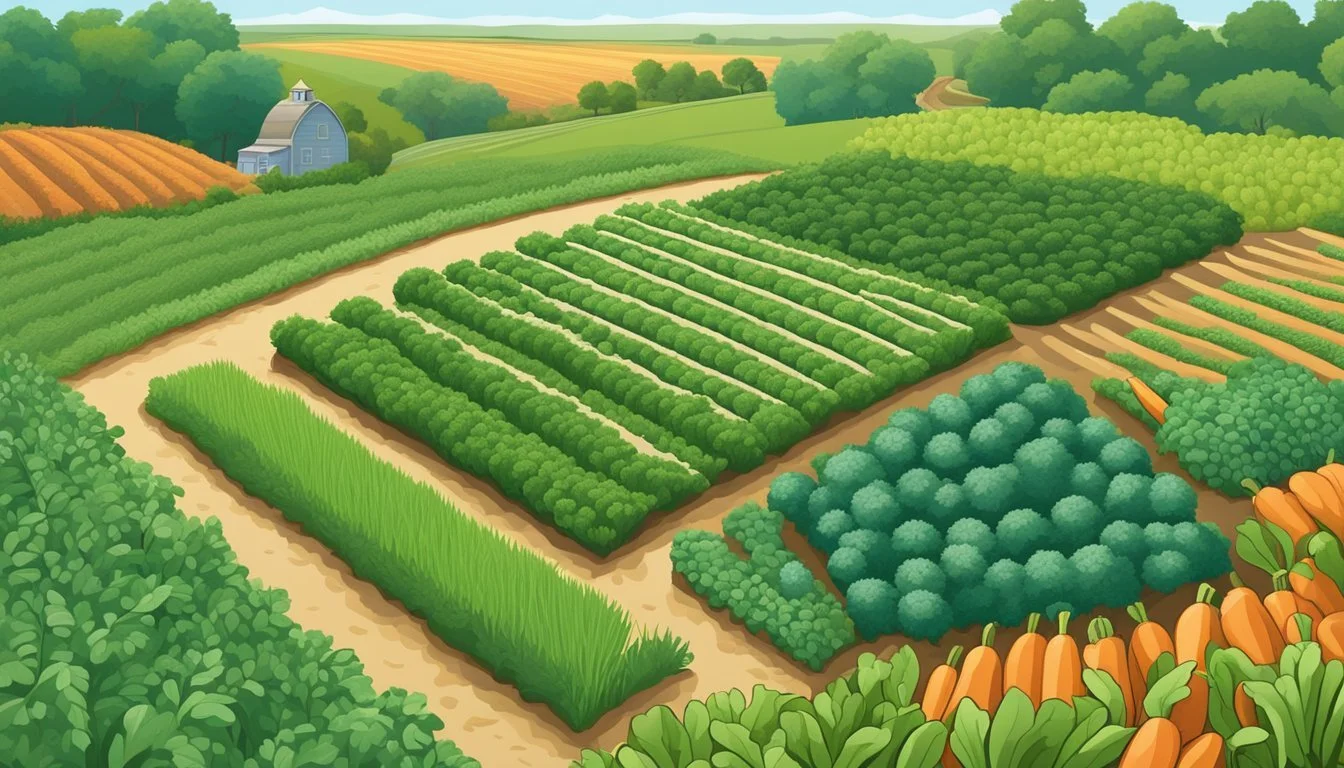Kansas Seasonal Fruit & Vegetables in December
Your Winter Produce Guide
This Article is Part of our Kansas Seasonal Fruit & Veg Calendar
In the state of Kansas, December marks a shift in local produce availability, as the cold weather influences what fruits and vegetables can be harvested during this time. Seasonal produce takes a turn away from the abundance of summer's bounty and towards the hardier winter selections. Farmers' markets and local grocers thus adjust their offerings, stocking up on items that can withstand the chill of the Midwest winter.
While fruit options are somewhat limited in Kansas during December, residents can still find stored apples (how long do apples last?) retaining their freshness and crispness from the fall harvest. These apples become a staple, and though fresh picking is not an option within the month, the stored varieties maintain much of their flavor and nutritional value.
Turning to vegetables, Kansas sees a variety of cold-weather crops thriving in December. Broccoli, with its deep green florets, often carries a slight purplish hue indicating its peak freshness. Green vegetables like kale (What wine goes well with kale?) and spinach are also prevalent, often grown in controlled environments that protect them from harsh outdoor temperatures. Root vegetables and the sturdy leaves of winter greens like curly endive and escarole are commonly found, as they favor the fall and persist through the early winter months.
Kansas Winter Produce Overview
During winter months, Kansas's agricultural output adapts to the cold, often offering a bounty of hardy, nutritious produce that can withstand the chill. Farmers markets throughout the state adapt their offerings to include a rich variety of seasonal produce.
Root Vegetables: A staple in the Kansas winter diet, root vegetables thrive in the colder temperatures. Shoppers can expect to find items such as:
Beets (how long do beets last?)
Carrots
Turnips
These vegetables are not only hearty and capable of surviving winter storage but also packed with essential nutrients.
Winter Greens: While many leafy greens prefer milder weather, some varieties hold up well against the frost. Look for:
Kale
Cabbage
Chard
These greens are versatile in the kitchen and can provide a fresh, nutritious boost to winter meals.
Cold Storage Produce: Certain summer-ripened fruits and vegetables are preserved through cold storage methods to extend their availability into the winter. Apples, for instance, are often available well into the cold months thanks to these storage techniques.
Hoop Houses and Greenhouses: Innovative farming practices, such as the use of hoop houses and greenhouses, allow for the extension of growing seasons of certain crops. This expands the range of produce available at farmers markets during winter.
Shoppers visiting Kansas farmers markets in December can look forward to a selection of seasonal produce that is both varied and nutritious, despite the colder conditions.
December Vegetables in Kansas
In December, Kansas offers a bountiful variety of vegetables adapted to the cold weather. The harvest includes hardy root vegetables, cruciferous staples, and nutrient-rich dark leafy greens that thrive during the state's chilly winter months.
Root Vegetables and Tubers
Kansas' December soil yields several root vegetables and tubers regarded for their ability to store well and provide hearty flavors for winter meals. Notably abundant are:
Potatoes: A versatile staple that can be stored for long periods.
Sweet Potatoes: Known for their sweet flavor and nutritional value.
Carrots: Offer a sweet, earthy taste and are perfect for a range of dishes.
Beets (how long do beets last?): Deeply colored with a rich, sweet flavor and ideal for roasting or pickling.
Turnips and Rutabagas: These often underappreciated roots can be mashed or roasted.
Radishes: Crisp and peppery, suitable for raw salads or as a garnish.
Parsnips: With a sweet, nutty flavor, parsnips are excellent in soups and stews.
Cruciferous Vegetables
December also sees a variety of cruciferous vegetables, which are known for their health benefits and versatility in cooking:
Broccoli: Offering tight florets and a deep green color, it's ideal for steaming or stir-frying.
Cauliflower: Creamy white heads that can be roasted or transformed into faux-mashed potatoes.
Brussels Sprouts: These miniature cabbages are best when roasted until caramelized.
Cabbage: A durable vegetable that can be used in hearty winter slaws or stews.
Kale: Robust and slightly bitter, kale is ideal for salads or chips when baked.
Dark Leafy Greens
As for dark leafy greens in Kansas, December days provide just the right conditions for these nutrient powerhouses:
Spinach: Tender and mild, perfect for salads or as cooked greens.
Fennel (how long does fennel last?): With its unique anise-like flavor, fennel adds a fresh taste to winter dishes.
These greens are packed with vitamins and offer a fresh counterpoint to the richness of other winter fare.
December Fruits in Kansas
In December, Kansas offers a limited selection of fruits due to its cold winter climate. However, locals and visitors can still enjoy certain varieties, typically hardy tree fruits or those cultivated in greenhouse environments.
Tree Fruits
Apples: Even into December, some apple varieties remain available in Kansas. These are typically late-harvest types which were picked in the fall and stored for winter sales.
Pears: Similar to apples, pears harvested during the late fall can still be purchased and enjoyed in December.
Persimmons: This seasonal fruit ripens in the fall and often remains available until the end of December.
Greenhouse Grown Fruits
Greenhouse technology enables the cultivation of certain fruits beyond their traditional outdoor growing season.
Temperature-controlled conditions allow for the production of some fruits, even during Kansas's colder months. However, specific varieties may vary based on local grower practices and greenhouse capabilities.
Preparation and Cooking Methods
When it comes to Kansas seasonal fruits and vegetables in December, one has a variety of cooking methods to preserve nutritional value and enhance flavor. The vegetables available during this chilly month, such as kale, spinach, and carrots, lend themselves well to a range of preparations.
Raw: Fresh vegetables like carrots and spinach can be enjoyed raw. They are often used in salads, adding a crisp texture and a nutritional punch.
Boiled: Root vegetables, such as carrots, can be boiled until tender. This method is simple and convenient, and boiled vegetables can be mashed or used as the basis for warming soups.
Roasted: Roasting amplifies the natural sweetness of vegetables like carrots. To roast, one should toss them with a bit of oil and seasonings and cook in an oven until caramelized.
Soups: Hardy greens like kale and spinach are perfect for soups. They can be added to boiling broth and simmered until they're just tender.
Grilled: Although less common in December, hardier vegetables can be grilled for a charred, smoky flavor. This method also works well for stored apples from the previous season.
Deserts: Apples are versatile and can be baked into various desserts. Baking concentrates the apple's natural sugars and complements the sweetness with spices like cinnamon.
These methods help maximize the taste and nutritional benefits of December's produce. One should choose the method that best suits the selected fruit or vegetable to create delightful dishes during the winter season.
Health Benefits of Seasonal Eating
Eating seasonally provides a host of benefits. Vegetables and fruits consumed during their appropriate seasons tend to be more nutritious. This heightened nutritional content includes key vitamins and minerals that the body needs to maintain health.
For instance, seasonal winter vegetables and fruits typically contain ample amounts of fiber, which is essential for proper digestion. Fiber helps in maintaining a healthy gut, which in turn supports overall wellness.
Beyond fiber, seasonal produce in the winter can also be rich in iron, a critical mineral for transporting oxygen throughout the body. Iron deficiency can lead to anemia, so incorporating iron-rich foods when they are fresh and abundant is beneficial.
Here are some seasonal produce benefits listed in a more organized fashion:
Nutrient Density: Fresher produce has a higher concentration of vitamins, antioxidants, and minerals.
Fiber Content: A diet high in seasonal fruits and vegetables boosts fiber intake, which is crucial for digestive health.
Iron Availability: Select seasonal produce contains iron, necessary for blood health.
Seasonal eating contributes not only to physical health with nutritious gains but can also influence the ecological footprint by reducing the distances food travels. Eating what is available locally reduces transportation and can lead to a lower carbon footprint, making it a choice that benefits both personal health and the environment.
Shopping for Seasonal Produce
In December, consumers looking to purchase fresh produce in Kansas will find a variety of fruits and vegetables that are in season. Shopping at local farmers markets and grocery store selections provide opportunities to access these seasonal items.
Local Farmers Markets
Local farmers markets in Kansas are excellent sources for the freshest seasonal produce directly from the growers. In December, markets may offer winter vegetables such as parsnips and hardy greens, along with storage crops like onions and potatoes. While fruit availability might be limited compared to the summer months, some markets might still offer late-harvest apples and greenhouse-grown items.
Grocery Store Selections
Grocery stores in Kansas will also have a range of seasonal produce, though the selection might come from a broader geographic area. Shoppers should look for root vegetables and winter squash, which are typically abundant during this time. Imported fruits, including pineapples and citrus, are generally available and complement the local offerings, ensuring a diverse selection even in the colder months.
Sustainable Agriculture in Kansas
In Kansas, sustainable agriculture is a practice that farmers and the wider community hold in high regard. Initiatives within the state focus on environmental stewardship, economic profitability, and social and economic equity. Multiple projects, such as the "Grow Your Farmers Market" initiative and the diligent work on post-harvest handling and production facilities for horticultural crops, reflect the commitment to these pillars of sustainability.
During the various seasons, Kansas farmers adapt their methods to maintain productivity and sustainability. For example, in summer, an emphasis is placed on crops like summer squash, which are tended using practices that conserve water and promote soil health. As fall approaches, preparations for crops like fall squash involve strategic crop rotation and cover cropping to protect and enrich the soil through the winter months.
Farmers markets across the state underscore the importance of sustainable practices by promoting locally grown produce, which reduces transportation emissions and supports the local economy. They operate through several seasons, offering seasonal produce to the community. Here's an outline of how seasons align with sustainable practices:
Summer: Emphasis on water conservation and growing heat-loving crops like summer squash.
Fall: Preparation for the winter with sustainable techniques like cover cropping.
Kansas has ingrained sustainable agriculture into its fabric, illustrating how sustainable practices are both practical and beneficial for the state's farming future.
Planning Seasonal Menus
When constructing seasonal menus for December in Kansas, one should focus on incorporating a range of produce that is harvested during the winter months. Utilizing items such as winter squash, fresh beets, and hearty potatoes not only supports local farmers' markets but also ensures that dishes are made with ingredients at their peak of freshness.
Winter Squash: A versatile ingredient, winter squash can be roasted, pureed, or used in soups.
Beets: Offering a vibrant color and earthy flavor, beets can enhance salads and side dishes.
Potatoes: A staple in many cuisines, potatoes can be featured in everything from creamy soups to crispy roasts.
Incorporating squash varieties can provide a comforting and warm note to the menus. They pair well with a wide array of herbs and spices.
While lettuce might not be the first produce one thinks of in colder months, hardy varieties can still thrive and are perfect for salads and garnishes. To add a touch of freshness to dishes that might otherwise be heavy, integrating lettuce can lighten the overall meal.
Remember, the availability of certain items like basil and other herbs might be limited due to cold weather; nonetheless, these can sometimes be sourced from farmers markets that feature greenhouse-grown produce.
Here's a simplified table to help plan a December menu:
Ingredient Suggested Use Winter Squash Soups, Purees, Roasted Dishes Beets Salads, Side Dishes, Roasted, Pickled Potatoes Soups, Mashed, Roasted, Baked Lettuce Salads, Sandwiches, Garnishes
By selecting seasonal produce, chefs and home cooks alike are guaranteed the freshest ingredients, reduced environmental impact due to lower transportation needs, and an opportunity to support the local economy during the festive season.








